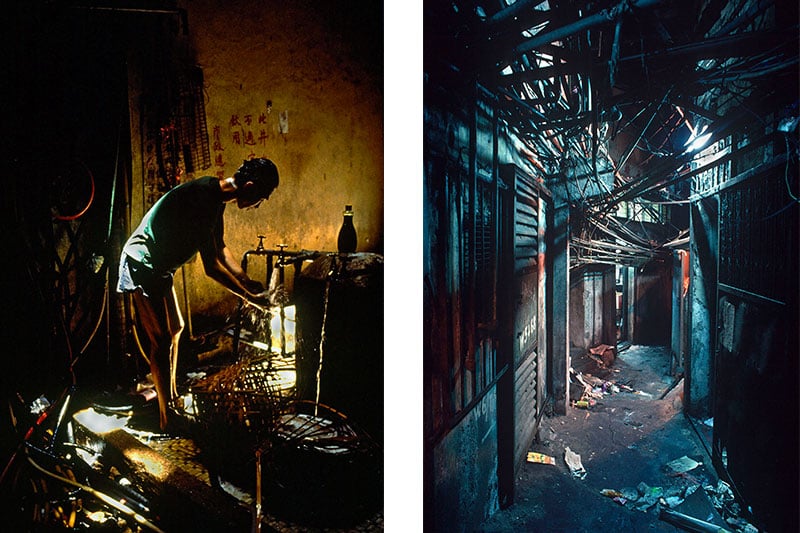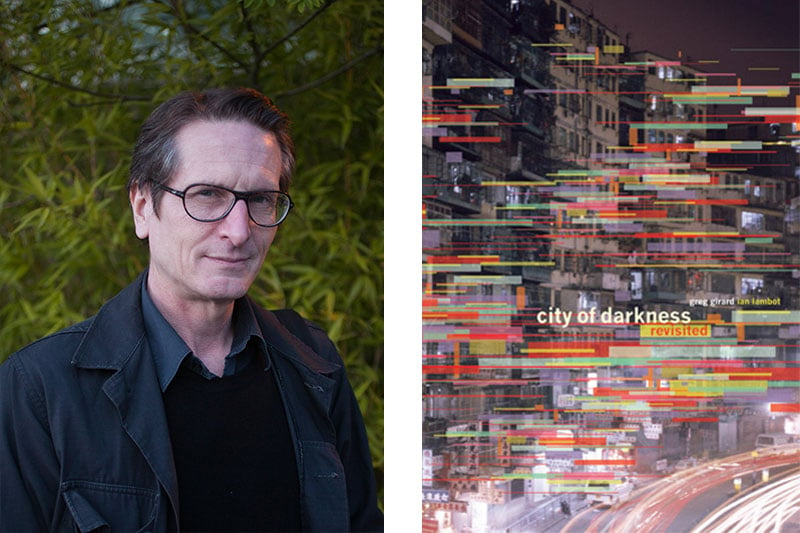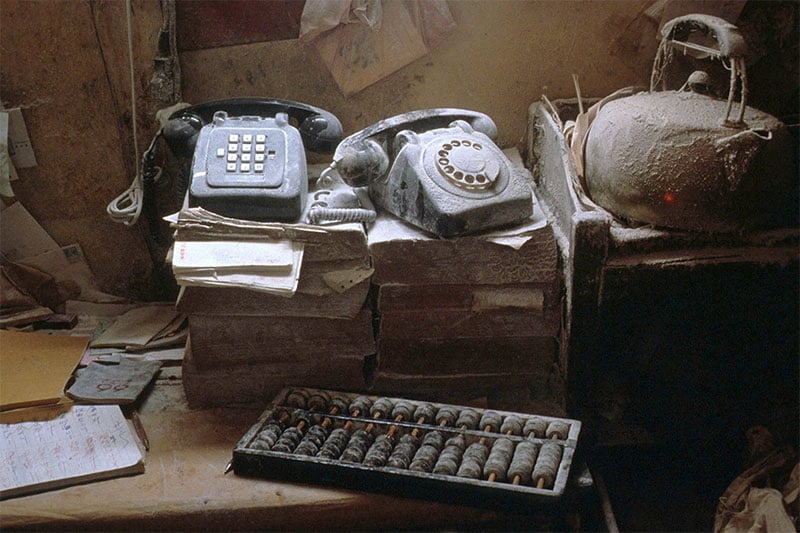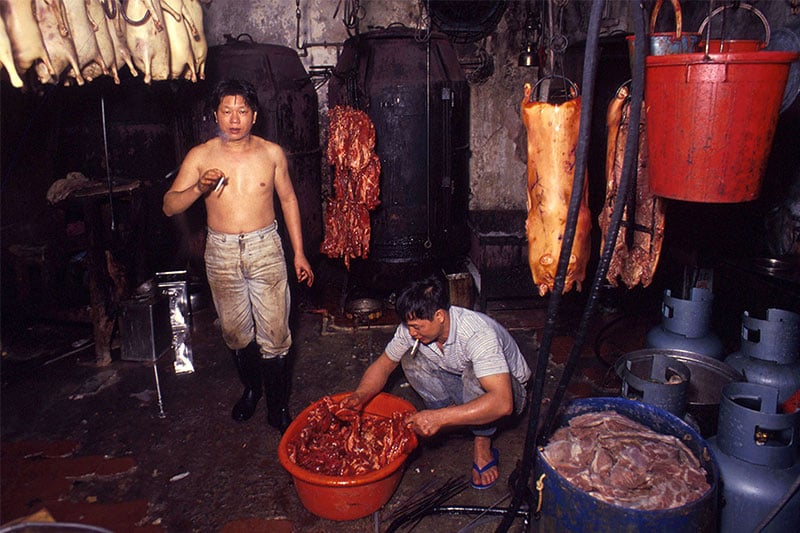Hong Kong’s Kowloon Walled City is often only remembered by those from that era. With his upcoming exhibition ‘City of Darkness,’ photographer Greg Girard talks to Hive Life about how he wants to keep its story alive.
Hong Kong’s infamous ‘Kowloon Walled City’ is a place often referred to in equal tones of horror and nostalgia. At its peak, the ungoverned settlement housed over 500,000 people, each boxed into 100-by-200-meter enclaves made up of buildings stacked on top of each other without foundations. Coined an anarchist slum, the city within a city was the only region exempt from British rule upon the lease of New Territories in 1898 and was collectively neglected by the British, China and Hong Kong administrations. With residents ranging from local fishball makers to foreign unregistered dentists, it had a reputation for its squalid conditions – and also its richness of life. And since its eventual demolition in 1993, stories of life within its walls have faded and become fables. For Canadian photographer Greg Girard, however, the telling of those stories has become a mission. Having stumbled across the city by accident in 1985, he dedicated himself to documenting the secret life of its inhabitants. In his upcoming exhibition City of Darkness at the Blue Lotus Gallery, he aims to remind Hong Kong of the blood that ran through the entangled wired network of veins that made up the heart of the city – and to preserve what was and still is a unique space in the city’s history of Hong Kong. Here, he tells his story of five years spent in one of his adopted hometown’s most infamous enclave.

Growing up in the suburbs of Vancouver, Greg found his feet in photography, intrigued by exploring livelihoods in different neighbourhoods. “As a 16 or 17-year-old, I travelled from the suburbs where I was growing up to downtown Vancouver. I started staying in cheap hotels, trying to meet people and photograph them. It wasn’t that far away geographically, but in any city, certain neighbourhoods lag in a certain way. That’s how I got my start making pictures of this nearby but very different world.”
With a desire to travel beyond his home country, Greg journeyed to Asia on a Philippine freighter and first set foot in Hong Kong in 1974. “Air travel was becoming the norm and those long sea journeys were on their way out. But, I was kind of determined to cross the Pacific by ship,” he remembers. “I fell in love with Hong Kong from that first visit. It’s a very dramatic, exciting place.”
You might also like Through the Lens: Capturing Nostalgic Realism Through Polaroids

Greg stumbled across the Walled City by accident when he was shooting something at the end of the old Kai Tak Airport runway in 1985. “I literally walked around the corner and saw this thing at the end of the block which did not fit in with the rest of the urban fabric. It was clear that it had to be the Kowloon Walled City. It was a place I’d only known by reputation. Nobody I knew had ever been there.”
Determined to capture threads of the underserved narrative through photography, Greg and project partner Ian Lambot went on to spend five years at the Walled City with a mission to tell the story as it was. “What we both discovered was that for all its reputation as a dangerous and dirty slum, it was much more than that. It was an incredible example of people caught between historical and political agendas who were in a kind of an administrative no man’s land. The only pictures I’d seen of the place were black and white pictures that were deliberately trying to make it look gritty, sensationalising the underside nature of the place – as if a subject like that didn’t deserve neutral treatment.”

To give the Walled City the treatment he felt it so deserved, Greg decided to turn a totally professional lens on life inside. “It was just at the beginning of my magazine photography career, so I applied the same techniques that I’d use to photograph a Fortune 500 CEO or celebrity. I took and used a portable Norman strobe unit. I carried quite a lot of gear to try to light it properly.” All of which, obviously, made him stand out. “In the beginning, I experienced a little bit of hostility because the assumption was that I was trying to make the place look bad. You’re using lighting equipment on a tripod. There’s nothing low profile about it. It’s very clear to everybody what you’re doing.” But, residents’ attitudes took a turn upon the announcement of the place’s demolition in 1987. “[Attitudes] changed a lot after the announcement that the place was going to be cleared. That was a signal that its days were numbered, and people were trying to document it.”

Walking around his exhibition, you’ll find photos from Greg and Ian’s revamped new 2014 edition of their book “City of Darkness Revisited,” with interwoven stories of different people tucked within those alleyways. Within these tales told, a postman particularly stood out to Greg. “Lam Po Chun delivered mail in the Walled City from 1979 to 1989, and one of the things I love about his story was that his route took him all through the place in its entirety: its alleys and stairways and rooftops. He acquired a kind of mental map, probably unlike anyone else. Because there were no elevators, Lam and his colleagues crossed rooftops between buildings to avoid a 12-floor walk up and down staircases. It’s an enlightening story of a job tends to get taken for granted, but, like so many things in the Walled City, there was always a fascinating backstory to the most mundane things: water, electricity, mail, to name just a few.”

When asked about some of his most memorable shots, Greg reminisces, “I have to say, there are maybe two kinds of pictures that defined the Walled City for me. One would have to be something down in the bowels, where life is taking place in the harsh conditions that were a big part of what the Walled City was. Another would have to be a rooftop view. People were working in hot conditions, in processing factories that were quite grim. The contrast between those kinds of places and being up on the roof at the end of the day was real. The space and the air when you emerge from climbing 13 floors of stairs, and it’s late afternoon, the light is beautiful, the kids are playing and the jets are arching past, flying into Kai Tak; people are picking up their laundry or just doing their homework or relaxing – it was a really fantastic view. It was a really special part of the Walled City, this interconnected rooftop garden of TV antennas and plants. It was actually a really pleasant place to be at the end of the day and a lot of people took advantage of it.”
From his own experiences in the City of Darkness and as a frequent traveller to Hong Kong, Greg says he has witnessed a change in the citizens’ sense of belonging: “I think the big change is that Hong Kong appreciates the city now in a way that it either didn’t exist or wasn’t apparent during the 1980s. It really is a generational change, and we see that in what’s happening now.” Greg encourages the current generation to be present and really see what’s on their doorsteps. “There’s no substitute for going there. I think Internet searches can make us a little bit lazy. We think, because we have the information, we know something, but there never will be a substitute for going and seeing it with your own eyes, seeing people and putting yourself out there, and try to make work in the real world.”
City of Darkness is showing at the Blue Lotus Gallery
Date: 8 November – 8 December 2019
Price: Free
Address: Blue Lotus Gallery, G/F 28 Pound Lane, Tai Ping Shan, Sheung Wan, Hong Kong
Open From: Wed – Sun: 11am – 6pm
“City of Darkness Revisited” will be for sale at Blue Lotus during the exhibition.
Other books by Greg Girard can be found here.
Related Articles
Japan Camera Hunter: Why Analog Photography is Making a Comeback
Photographer Philip Volkers Documents A Decade at Burning Man





